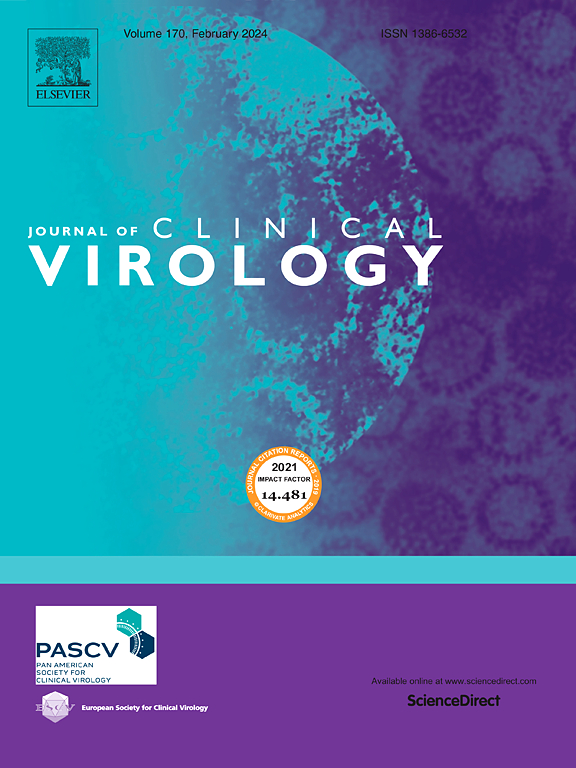Diagnostic insights from the 2024 West Nile Virus outbreak in Israel: Emphasizing the utility of molecular testing over serology
IF 3.4
3区 医学
Q2 VIROLOGY
引用次数: 0
Abstract
Background
In 2024, Israel experienced its largest West Nile Virus (WNV) outbreak, reporting 934 cases. Diagnosis primarily relies on serological testing for IgM antibodies; however, cross-reactivity with other flaviviruses and prolonged IgM persistence complicate interpretation. Molecular testing is less utilized due to concerns about the short duration of viremia and potential false negatives.
Objectives
To evaluate the diagnostic reliability and persistence of WNV molecular testing across different sample types compared to serological testing, leveraging the extensive sample collection during the 2024 outbreak in Israel.
Study design
Samples from 919 WNV cases, including whole blood (WB), serum, urine, and cerebrospinal fluid (CSF) were evaluated. WNV RNA, IgM antibodies and IgG avidity were tested on all sample types, serum and CSF and serum, respectively.
Results
WNV RNA was detected in 91 % of WB samples, and observed up to 52 days post-symptom onset. Detection rates were lower in serum (82 %), urine (71 %), and CSF (53 %), with shorter detection windows. Viral concentrations were highest in urine, followed by WB with serum, and CSF, the lowest. IgM antibodies were present in 83 % of serum and 86 % of CSF samples. RNA detection rates were comparable between hospitals (91 %) and health maintenance organizations (HMOs) (92 %), but IgM positivity was significantly higher in hospitals (91 %) than in HMOs (69 %).
Conclusions
Molecular testing on WB offers the highest sensitivity and longest detection window for WNV RNA. Molecular diagnosis enhances accuracy, facilitates earlier detection, and improves clinical and public health response strategies compared to serological diagnosis.
来自以色列2024年西尼罗病毒爆发的诊断见解:强调分子检测对血清学的效用
在2024年,以色列经历了最大的西尼罗病毒(WNV)爆发,报告了934例病例。诊断主要依靠IgM抗体的血清学检测;然而,与其他黄病毒的交叉反应性和IgM持续时间的延长使解释复杂化。由于担心病毒血症持续时间短和潜在的假阴性,分子检测较少使用。目的利用2024年以色列疫情期间广泛采集的样本,评估不同样本类型的西尼罗河病毒分子检测与血清学检测相比的诊断可靠性和持久性。研究设计对919例西尼罗河病毒病例的全血(WB)、血清、尿液和脑脊液(CSF)样本进行评估。分别检测各样品类型、血清、脑脊液和血清的西尼罗河病毒RNA、IgM抗体和IgG亲和力。结果在91% %的WB样本中检测到swnv RNA,并在症状出现后52天观察到。血清(82 %)、尿液(71 %)和脑脊液(53 %)的检出率较低,检测窗口较短。尿中病毒浓度最高,血清中其次为白蛋白,脑脊液中最低。IgM抗体存在于83% %的血清和86% %的脑脊液样本中。医院(91 %)和健康维护组织(92 %)的RNA检出率相当,但IgM阳性率在医院(91 %)明显高于健康维护组织(69 %)。结论WB分子检测对WNV RNA具有最高的灵敏度和最长的检测窗口。与血清学诊断相比,分子诊断提高了准确性,促进了早期发现,并改善了临床和公共卫生应对策略。
本文章由计算机程序翻译,如有差异,请以英文原文为准。
求助全文
约1分钟内获得全文
求助全文
来源期刊

Journal of Clinical Virology
医学-病毒学
CiteScore
22.70
自引率
1.10%
发文量
149
审稿时长
24 days
期刊介绍:
The Journal of Clinical Virology, an esteemed international publication, serves as the official journal for both the Pan American Society for Clinical Virology and The European Society for Clinical Virology. Dedicated to advancing the understanding of human virology in clinical settings, the Journal of Clinical Virology focuses on disseminating research papers and reviews pertaining to the clinical aspects of virology. Its scope encompasses articles discussing diagnostic methodologies and virus-induced clinical conditions, with an emphasis on practicality and relevance to clinical practice.
The journal publishes on topics that include:
• new diagnostic technologies
• nucleic acid amplification and serologic testing
• targeted and metagenomic next-generation sequencing
• emerging pandemic viral threats
• respiratory viruses
• transplant viruses
• chronic viral infections
• cancer-associated viruses
• gastrointestinal viruses
• central nervous system viruses
• one health (excludes animal health)
 求助内容:
求助内容: 应助结果提醒方式:
应助结果提醒方式:


